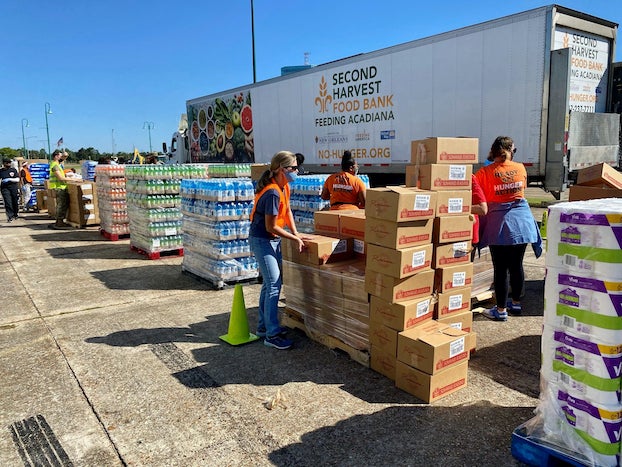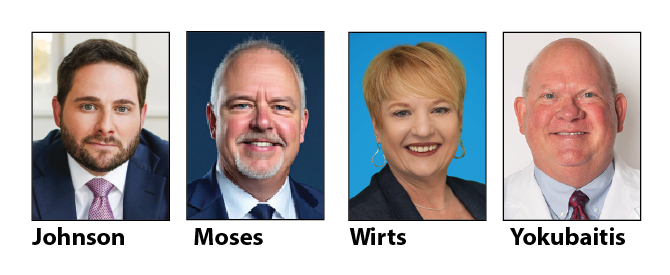Feeding the hungry: Each month, Second Harvest Food Bank distributes 39 million pounds of food across South La.
Published 8:04 am Sunday, May 22, 2022

- Volunteers from Second Harvest Food Bank of Acadiana distribute food to residents during food distribution for Southwest Louisiana. With warehouses in New Orleans and Lafayette, Second Harvest distributes more than 39 million pounds of food and groceries to 700-plus partners and programs across South Louisiana, reaching at least 100,000 people each month. (Special to the American Press)
One in five households in Louisiana experience food security, but Second Harvest Food Bank is working to come up with ways to provide better access to affordable and nutritious food for those in need.
In Southwest Louisiana, Jeff Davis Parish had the highest rate with 18.6 percent of the population being food insecure or highly vulnerable to food insecurity in 2020, according to the latest data provided by Second Harvest.
In Calcasieu Parish, 17.8 percent of the residents did not have reliable access to affordable and nutritious food with 17.3 percent considered to be food insecure in Beauregard Parish. Cameron Parish had the lowest rate of food insecurity at 13.7 percent.
“I can’t define why people are food insecure because there is a bunch of different reasons, but we know people are food insecure because we know people are having a hard time providing those additional meals for themselves,” said Paul Scelfo, regional director for the Second Harvest Food Bank of Acadiana which serves Southwest Louisiana.
Food insecurity, or a limited access to adequate food, can affect people in different ways, Scelfo said.
“As an overall view, a person or a family experiencing food insecurity simply means that through whatever means – access, opportunity or whatever means – that individual or that family cannot provide about 170 meals a year for themselves,” Scelfo said.
“If you are providing three meals a day based on 365 days a year that’s about 1,100 meals a year,” he continued. “If for some reason you run short financially or because you live in a food desert, you can’t get those meals. If you are short about 170 meals a year then you are considered to have food insecurity.”
Food deserts refers to those areas in rural communities that have limited access to healthy, affordable food and are located within 10 miles from a grocery store.
People living in rural communities face hunger at higher rates than people who live in urban areas.
In Louisiana, rural communities make up 45 percent of parishes in the state and 71 percent of the parishes with the highest rates of overall food insecurity.
Scelfo said people of all ages, races, ethnicities and backgrounds can come in and out of food insecurity based on different social and economic situations which can limit access to healthy and adequate food.
Currently two-thirds of families in America are living paycheck to paycheck, he said. Many situations including rising fuel, utilities and food costs, health issues, low-paying jobs and unemployment have increased the need for food assistance.
With warehouses in New Orleans and Lafayette, Second Harvest distributes more than 39 million pounds of food and groceries to 700-plus partners and programs across South Louisiana, reaching at least 100,000 people each month.
“The majority of people that we work with are people working very hard and just falling short in providing meals for themselves and their families,” he said. “With an 8.5 percent inflation rate, our salaries are not keeping up right now so those family budgets are just getting tighter and tighter.”
As inflation rises, Scelfo said food banks across the area are seeing more people reach out to food pantries for additional help each month. Many are those who are having to make difficult choices just to make ends meet, he said.
“I’ve talked to people who were making decisions on whether to put tires on their car to get to work or putting food on the table, that’s food insecurity,” he said.
“There are a lot of things we do to help move that needle from food insecure to food security,” he said. “If we’re working with people above 65 and they are considered food insecure the best way we can help them is to provide them with a prepared meal. If it’s school aged children, we may be able to help by providing them meals through a summer feeding program.”
Scelfo said the main goal of Second Harvest is to create a partnership and develop opportunities to educate people, advocate for them and to reduce food desert areas in rural communities so that when they have a need, they can reach out to a food pantry.
“When we are reaching out to the public, fresh produce or frozen proteins are the most popular items that people need, but sometimes it’s the most expensive for us to acquire,” he said. “But we try to meet the needs of our pantry partners.”
Second Harvest recently helped God’s Pantry in Jennings acquire a walk-in freezer to help them increase its distribution capabilities and help provide more frozen food for clients in Jeff Davis Parish. The pantry distributes food to 1,200 residents twice a month.
“What we saw with God’s Pantry is that we could increase their distribution by having a bigger freezer, so that was a great opportunity to work with them in getting the funds to put their freezer in so now they can distribute an increased amount of product in the community,” he said.
Second Harvest was able to help distribute 1.6 million pounds of food-related items in Jeff Davis Parish in 2020, Scelfo said. Its goal moving forward is to increase that to 5 million pounds in the next 10 years, he said.
Second Harvest is planning to add a warehouse in Calcasieu Parish to increase capacity to provide access to food closer to home for those in need in Calcasieu, Cameron, Jeff Davis and Beauregard parishes.
It is also working with McNeese State University to provide a kitchen to offer hot pre-made meals for residents. Other goals include adding a community garden to work with local doctor officers to incorporate more vegetables into meals of those people with health issues and food insecurities and adding mobile markets in rural areas to increase local access to food.
It also hopes to expand its nutrition programs to help people understand the valve of nutrition and the type of food they are getting and develop partnerships in local communities through donations of food and money and increasing volunteer opportunities.
More information about Second Harvest programs, including local food pantries, or how to help can be found on-line at no-hunger.org.





